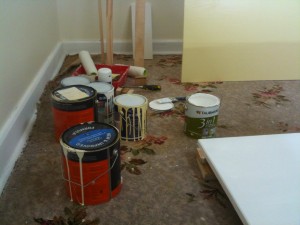Whenever I do painting, I’m always thankful I live in just three dimensions, and not, say, two hundred and three. Now, I know that sounds a bit odd, but there’s a good reason for it.

Perhaps, like me, you’ve been surprised at how a thin layer of paint on just an average-sized room can use up a whole tin or two of paint. Where does it all go? A little bit of geometry will tell you – if the room is 3m by 3m (about 3 yards by 3 yards) and the walls are 3m high, the four walls have a total area of 36 square metres. A tiny 0.1mm layer of paint, spread over such a large area, comes to about 3.6 liters, or about 1 gallon. So you lose a significant amount of the room’s volume just by painting the walls. It’s a tiny fraction – about 1 part in 7500. Still, if you painted the room every day for a few years, you’d start to see the room get smaller as the sheer volume of the paint began to crowd out the empty space in the interior of the room. (It would also be a very expensive hobby.)
If the world was 203 dimensional instead of 3 dimensional, things would be much worse – and not just because my cube-shaped room would have 404 walls (and a ceiling and a floor). Painting these 404 walls, 0.1mm of paint, I would lose 1% of the volume of the room. You’d want to be very careful to get the color right, because you couldn’t repaint very often!
Oh, and if you think edging is a pain, at least a cube-shaped three-dimensional room has just 12 edges, and not 82012 like the 203 dimensional room.
It would be quite hard to walk around a 203 dimensional room. If it were a 3m cube, fully 13% of the room’s volume would be 1 cm away from the wall or closer. That new paint smell would stick around, and you’d always be bumping into the wet paint.
In higher dimensions, this only gets worse. The unfortunate denizens of 20003 dimensional space would never paint their walls, since each coat would cut the volume of their room in half. And the inhabitants of 2000003 dimensional space find that practically all their room space is on the walls.
As abstract as this sounds, it actually has very practical applications. For example, you can model, say, a cup of tea as a point in a multiple-quadrillion-dimensional room. The points on the surface are the “normal” ways tea behaves – getting cooler, sugar and milk staying mixed, spilling if you tip it, and so on. The points away from the surface are stranger, but physically possible, ways for tea to behave – getting warmer, half freezing and half boiling, the sugar spontaneously crystallizing out, or hovering in a ball above the cup. All of these are physically possible – if the atoms and molecules will just line up in exactly the right way.
How will your cup behave? It will choose a random point in its metaphorical room. Since its room has so many quintillions of dimensions, the chance is 99.9999999999999999999% or more that this point will be near the wall of the room, and your tea will behave like perfectly normal tea. Your tea might do something strange, but that would be like winning lotto. Exactly like winning lotto, in fact, except that the lotto balls’ “room” has only several hundred dimensions. That’s why we hear of people winning lotto, but never hear of people whose tea spins in a ball above the cup.
So, think of that next time you see someone painting. And if it’s getting them down or they’re running out of paint, ask them to cheer up – the world in which they are painting is just three dimensional, after all!